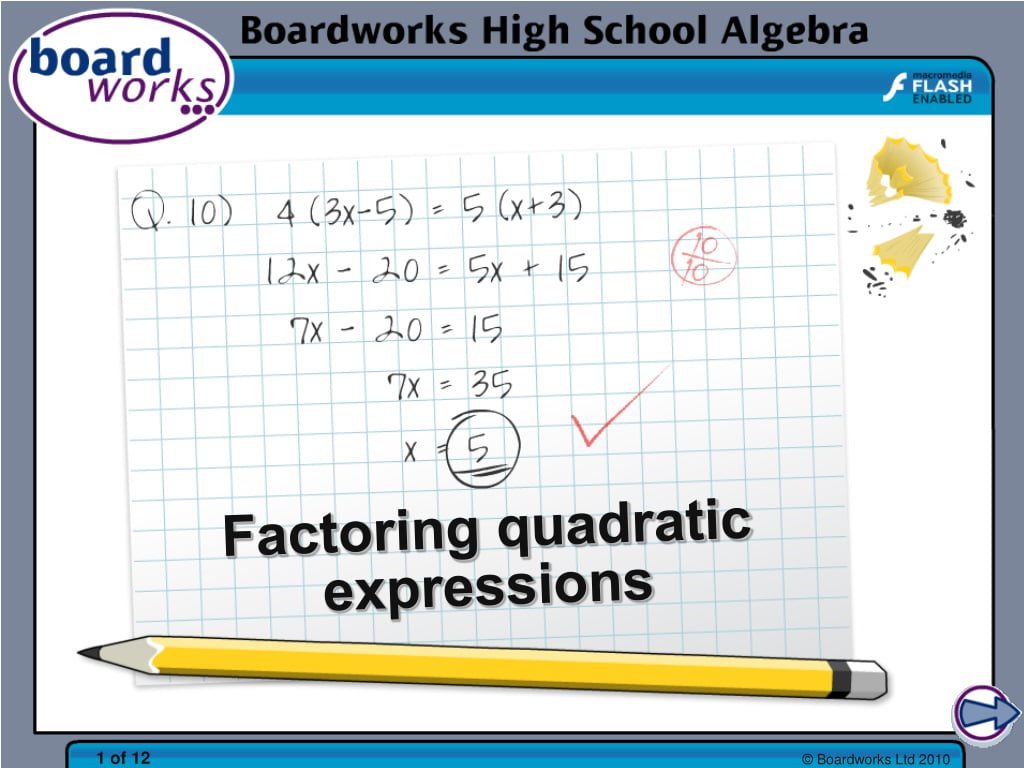Introduction
Factoring quadratics is a fundamental skill in algebra that serves as a bridge between basic arithmetic and more advanced mathematical concepts. Quadratic equations are equations that can be written in the form ax^2 + bx + c = 0, where a, b, and c are constants and a is not equal to zero. Factoring these equations involves breaking them down into simpler expressions, making it easier to find their roots or solutions. In this comprehensive guide, we will explore the methods, strategies, and tips for factoring quadratics effectively.
I. Factoring Quadratics Using the Greatest Common Factor (GCF)
Factoring a quadratic equation often begins with identifying the greatest common factor (GCF) among the coefficients. The GCF is the largest number that evenly divides each coefficient. Here’s a step-by-step process for factoring quadratics using the GCF:
- Identify the GCF of the coefficients a, b, and c.
- Divide each term by the GCF.
- Rewrite the equation with the factored GCF outside the parentheses.
- Simplify the expression inside the parentheses.
- If possible, further factor the expression inside the parentheses, which may lead to real or complex solutions.
II. Factoring Quadratics with a Leading Coefficient of 1
Quadratic equations in the form x^2 + bx + c = 0 are the simplest to factor since the leading coefficient is 1. The goal is to find two numbers that multiply to c and add up to b. Here’s a step-by-step process for factoring such quadratics:
- Identify the values of b and c.
- Find two numbers that multiply to c and add up to b.
- Rewrite the equation as (x + m)(x + n) = 0, where m and n are the two numbers found.
- Set each factor (x + m) and (x + n) equal to zero and solve for x.
III. Factoring Quadratics with a Leading Coefficient Not Equal to 1
When the leading coefficient (a) is not 1, factoring requires a bit more effort. In these cases, you may use methods like the AC method or trial and error. Here’s a step-by-step process for factoring quadratics with a leading coefficient other than 1:
- Multiply the leading coefficient a by the constant term c, giving you ac.
- Find two numbers that multiply to ac and add up to the middle coefficient b.
- Rewrite the equation in the form (dx + m)(ex + n) = 0, where d and e are divisors of a and m and n are the two numbers found.
- Set each factor (dx + m) and (ex + n) equal to zero and solve for x.
IV. Factoring Special Cases
Some quadratic equations follow specific patterns, making factoring quicker and more straightforward. These include:
- Perfect Square Trinomials: Equations in the form (x^2 + 2abx + a^2) = (x + a)^2 and (x^2 – 2abx + a^2) = (x – a)^2 can be factored as perfect squares.
- Difference of Squares: Equations in the form (x^2 – a^2) = (x + a)(x – a) are considered difference of squares and can be factored easily.
- Quadratics with Repeated Roots: When the discriminant (b^2 – 4ac) is zero, the quadratic equation has repeated roots, which can be factored as (x – p)^2, where p is the single root.
V. Factoring Complex Quadratics
Some quadratic equations do not have real solutions but instead have complex roots. These are quadratic equations in the form ax^2 + bx + c = 0, where the discriminant (b^2 – 4ac) is negative. To factor such quadratics, you can use the quadratic formula to find the complex roots:
x = (-b ± √(b^2 – 4ac)) / (2a)
Once you’ve found the complex roots, rewrite the equation as a product of linear factors involving these roots. For example, if the roots are x = p + qi and x = p – qi, you can factor the equation as (x – (p + qi))(x – (p – qi)) = 0.
VI. Tips for Factoring Quadratics
- Practice is key: The more you practice factoring quadratics, the more proficient you will become.
- Pay attention to the discriminant: It helps determine whether the equation has real or complex solutions.
- Keep an eye out for patterns: Recognizing perfect squares and the difference of squares can simplify factoring.
- Check your work: Always verify your factored form by multiplying it back to ensure it’s equivalent to the original equation.
Conclusion
Factoring quadratics is an essential skill in algebra, as it forms the basis for solving a wide range of mathematical problems. By understanding the different methods for factoring quadratics and practicing regularly, you can gain confidence in your algebraic abilities and improve your problem-solving skills. Whether you’re dealing with quadratics with leading coefficients of 1 or other values, special cases, or complex solutions, this comprehensive guide has provided you with the knowledge and techniques needed to factor quadratics effectively. Remember that practice is key to mastering this fundamental algebraic skill.




